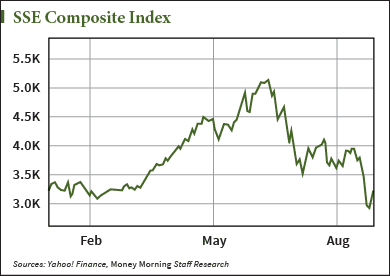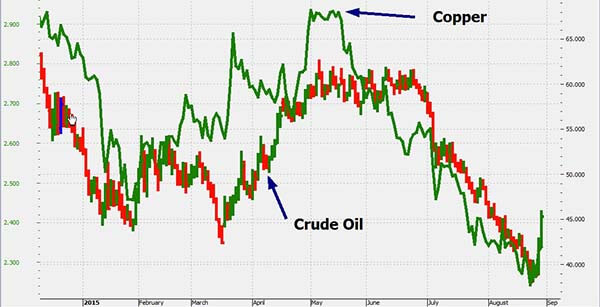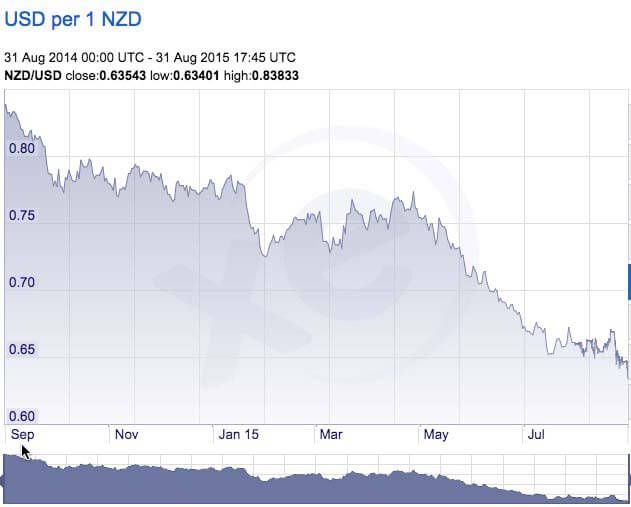How To Beat This Market’s “Three Cs” Of Risk
The last few weeks of trading have been downright rough…
The markets staged a "whistling past the graveyard" rally for a little more than a week after the Aug. 24 crash only to come tumbling down again by 3% on Sept. 1 as nearly every sector was hit.
Robust technical support levels that were years in the making have been snapped like so many little twigs.
Key indicators have all but failed traders who are scrambling to find bottoms to trade off of, and the Chicago Board of Options Exchange Volatility Index (VIX) has been breaking six-year records, topping 53 on Aug. 24 and 30 on Sept. 1.
The sheer breadth of the chaos is matched only by the growing chorus of pundits speculating on the drivers of the chaos.
Let them speculate and fumble around in the dark. What's really rocking this market is what I call the "Three Cs."
Here they are – plus the two sectors that will rise above it all…
The First 'C' Is… China

This is really where it all starts…
We know by now that poorly prepared Chinese retail investors leveraged themselves up to their collective eyeballs and laid their life savings on the line for a shot at becoming the next millionaire on the markets in Shanghai and Shenzhen.
Chinese regulators sure made it easy, with extremely slack margin requirements and an officially sanctioned ethos of greed. That drove the markets skyward in a classic case of "irrational exuberance."
In mid-June, the bubble burst and the Chinese markets have been bleeding ever since, despite ever more extreme measures by the Chinese government to prop them up.
Margin calls and losses are leaving those investors penniless.
At the same time, the Chinese economy appears to be slowing down – although it's still growing at almost double the rate of the United States or European Union.
Many investors' first clue of that was the People's Bank of China's move to devalue the yuan. It was a logical move to make, but many investors read it as a frantic move to boost exports and shore up the economy.
That "spooked" people and sent them selling – all too easy to do if you don't have the full story.
The Second 'C' Is… Commodities
So China is still posting enviable growth rates by Western standards, but there is a noticeable slowdown, and that's exacerbating a global decrease in demand for commodities – and Idon't mean index or bond futures.
Some of these physical commodities don't really correlate with the economy, but most of the really important ones do – especially oil and copper.
Not only are those critical to actually building and moving things, they're a near-perfect gauge of the economy; oil drives the production side, and copper the consumption side.

Crude oil tends to lead the charge up and down, with copper following the way as a confirmation for expansion and contraction of the worldwide economy.
Since China has the fastest-growing economy in the world, I like to use these barometers and tie them to the markets.
But something odd happened in May: The tail wagged the dog.
In other words, copper dropped off in May, but crude didn't confirm that drop until June.
That drop, however strange, signaled a bear for China and, indeed, the entire world.
The Third 'C' Is… Currencies
I consider commodities drops like these to be short-term gains and long-term losses.
They're short-term gains for the consumer, who enjoys lower prices at the pump, but long-term losses for the global economy.
Consumers, and their money, play a big role in this picture…

Now, as a worldwide consumer, I love seeing my U.S. dollar rise against foreign currencies, because it makes my dollar stronger.
As of this writing, I am securing some oceanfront property in New Zealand.
When I started the negotiations earlier this year, the New Zealand dollar was worth $0.77.
But right now, the kiwi is worth just $0.64. My greenback can now buy 17% more kiwis, so, as far as I'm concerned, the property I'm buying just became 17% cheaper – and you'd better believe I'm having the contract drawn up in New Zealand.
And that's really the final link in this chain of volatility. China is over-leveraged with a shrinking economy, so it's not consuming enough commodities, which in turn drives the countries that are providing those commodities, like oil and minerals – Canada, Australia, and, sure enough, New Zealand (just to name a few) – to devalue their currencies to stay afloat and competitive.
I expect this "chain" to spin and even accelerate in the next several months, but there are some really good opportunities hidden in all of this…
Two Sectors That Rise Above It All
So, while it's fine to be short in this market, and it's smart to bet on a turnaround, one of the best approaches is to focus on stocks in sectors that don't correlate so highly with the "Three Cs."
And in this market, that means consumer services, as tracked by the iShares Dow Jones US Consumer Ser. (ETF) (NYSE Arca: IYC), and healthcare, as tracked by the iShares S&P Global Healthcare Sect. (ETF) (NYSE Arca: IXJ).
These two sectors are holding their own right now, with these funds giving up just .35% and 2.35% over the past week – not bad for this market. Individual stocks in these sectors have even managed to gain ground, and we can still reasonably expect these sectors to make money in a year that will almost certainly see the indexes book a loss.
Options are another fantastic way to hedge volatility right now. In my Power Profit Trades service, we're deploying options strategies with some of our favorite stocks as a way to lower our cost and risk in the constant fight against the "Three Cs."
Disclosure: You can participate in Tom's Power Profit ...
more


